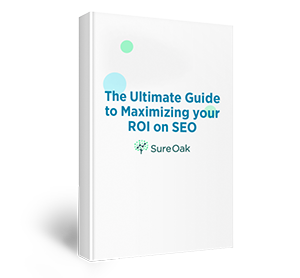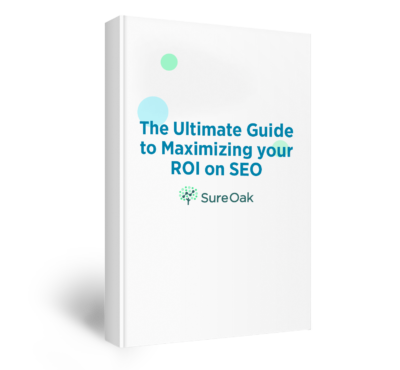In recent years, we’ve seen an explosion in the number and sophistication of SaaS offerings. While these new products offer compelling solutions to a vast array of problems, effective marketing presents challenges for firms needing help to connect to their target audience. Adopting a SaaS SEO strategy can help your business rise above the competition to reach the right people.
What is SaaS SEO? SaaS SEO refers to a marketing strategy that uses SEO best practices to drive website traffic to SaaS websites to increase sales and brand awareness.
Why SEO for SaaS — An Increasingly Competitive Landscape

As the SaaS space grows increasingly saturated, standing out has become increasingly difficult. Fortunately, SEO offers a way out. Utilizing SEO best practices can cause your website to rise in Google’s search rankings reaching new customers and driving more traffic to your website. One of the best parts about using an SEO content strategy is that it touches on your audience at multiple stages in the customer journey. From awareness to advocacy, SEO does more than drive sales. It also fosters deep engagement with your brand offerings.
Scalable Growth
The ability to scale growth highlights SEO’s importance in a SaaS business. SEO allows firms to achieve scalable growth in a way that pay-per-click digital advertising can’t. With paid advertising campaigns, costs tend to increase over time. That’s because digital advertising hooks the most interested consumers first. After the fertile soil becomes exhausted, you’ll be forced to plow the more marginal areas.
By contrast, a well-thought-out SaaS SEO strategy will provide scalable growth. Evergreen SEO content can continue to bring in leads for years after its publication date. SEO requires a run-up period. Realistically, you shouldn’t expect to see returns for at least 40 days, although you’ll often have to wait at least several months.
You can think of regularly publishing SEO content like a snowball rolling downhill. The further it travels, the bigger it gets. So long as you keep to a schedule and continue to produce high-quality and informative content, you can expect your website traffic to experience exponential growth.
Help Reduce Your Cost-Per-Acquisition
As we discussed above, traditional pay-per-click advertising has a tendency to trend upward over time as easy pickings become exhausted. By contrast, SEO content runs in the opposite direction. As you continue to publish, you’ll find that your customer acquisition cost falls with each new piece. Again, going back to our snowball analogy, the gradual build-up required for SEO means that as your website accumulates additional content, it shoots up the search engine results page (SERP).
Research has shown that only a few searchers go beyond the first page of Google. The first few links collect the lion’s share of clicks, even on the first page. While the marginal cost of producing SEO content stays the same, the additional revenue it creates for your website increases.
Integration With Other Marketing Channels
You don’t need to silo your SEO content writing strategy. One of the great things about SEO content is its versatility. You can integrate your SEO strategy with your Google Ads strategy. Making sure your content ranks highly on Google’s SERP means you’ll dominate the top of the search result’s page.
Use social media to your advantage. Share your catchy content on popular platforms like Facebook, Instagram, and Twitter. If your content hits a nerve, you can take advantage of retweets and shares to gain exposure at no cost to you. By a similar token, integrating SEO content into your PR strategy can accomplish a similar goal through traditional media.
Important SaaS SEO Ranking Factors
The Google search algorithm is famously something of a black box. However, while the exact details may be fuzzy, we have a pretty good idea of what core variables influence ranking. Use these SEO strategies for SaaS to increase sales and build brand engagement.
User Experience
User experience (UX) has become increasingly important in Google’s ranking criteria in recent years. Good UX design favors ease of use and intuitive systems. Making your website, user-friendly decreases bounce rates and increases dwell time. Bounce rate refers to how many users exit a website shortly after arrival. Dwell time refers to how long a user stays on the website.
The most recent iteration of Google’s search algorithm favors websites that engage users. A key measure of engagement is the average length of stay on a webpage. With so many choices, internet searchers have no reason to endure an uncomfortable or difficult-to-navigate website.
Domain Authority & Link Profile
Moz, an SEO software company, provides websites with a domain authority score. Domain authority ranges from one to 100, with 100 representing a perfect score, and it acts as a proxy measure for how well a website is likely to perform on Google’s rankings. Moz looks at 40 criteria to determine a number that best represents a website’s competitiveness in SERP rankings.
The number of high-quality backlinks or external hyperlinks connecting to your website is the number one factor feeding into your domain authority. However, you need more than just a large number of backlinks. Remember, these should come from quality sources. Other high-ranking websites within your niche typically work best. Creating high-quality content is the best way to do this.
However, even the best websites need a push. Guest posting on a popular website remains one of the best ways to build up an ecosystem of high-quality backlinks pointing to your website. Providing helpful answers on popular forums can also help, so long as it’s done sparingly. Whatever you do, stay away from black hat marketing agencies that promise large numbers of backlinks in exchange for money. In addition, backlinks originating from spammy websites can hurt your website’s domain authority.
Page Speed & Technical Factors
Page speed is an essential factor relating to user engagement. In 2024, there’s no excuse for slow load times. Google will actively penalize websites that fail to load quickly, and with good reason. The research shows internet searchers strongly prefer websites that load quickly. A quarter of internet users will navigate away from a website that takes more than four seconds to load, while a one-second load delay lowers customer satisfaction by 16%. Ensuring a speedy load time and smooth functioning will keep your website ranking high on Google’s SERP.
Social Signals
Social signals encompass the full range of a website’s social media presence. For example, whenever someone retweets or shares a blog post on Facebook, your social signal boosts. Although Google came out with an official stance against the use of social signals in 2014 in its search engine algorithm, a recent survey of more than 2,800 SEO specialists suggests that enhancing your social signals can improve your organic SERP ranking. With the average internet user spending roughly two and a half hours a day on social media, social signals are too potent to ignore.
Content Optimization
It’s no secret that Google prefers content served up a certain way. Disagreements still rage about the correct length for an SEO article. However, most estimates come down between 1,500 and 2,000 words. Articles with different-sized headings (usually referred to as H1s, H2s, H3s, etc.), bullet point lists, bite-sized writing chunks, infographics, photos, embedded videos, a combination of internal and external embedded hyperlinks, and appropriate keyword usage tend to rank highly on Google’s SERP.
Creating a SaaS SEO Strategy
Learn how to create an SEO strategy with the following tips. However, before we get started, it’s important to note that SEO for SaaS companies and SEO for software companies differs somewhat from traditional SEO practices.
Keyword Research & Keyword Analysis for SaaS
Keyword mining tools like those provided by Moz, Clearvoice, and Semrush let you look up relevant keywords to scatter through your content. These keywords and phrases help connect you to the right searchers. For example, let’s say I search for “coffee tables,” Google will locate web pages containing that phrase and arrange them on its SERP.
Until 2013, Google primarily used keywords to create its rankings. Unfortunately, this led to unsavory practices like keyword stuffing. To combat these actions, more recent iterations of Google’s algorithm favor content that naturally integrates keywords. Google also looks for semantic keywords or related words that touch on a similar search intent as the main keyword. For example, “home decor” and “home furnishings” are semantic keywords for “coffee tables.”
Competitor Analysis
Numerous tools have popped up that let you analyze the competition. Some, like Moz’s domain authority, let you directly compare your website to your closest competitors. Your domain authority is best understood as a contextual tool. Although 100 is the highest score available, only some websites achieve anything close to that. Fortunately, you’re not competing against Facebook or YouTube.
Identifying close competitors in your space can help you spot gaps in the produced content. If you own an online specialty pet food store, and your competitors have yet to address a rare but increasingly popular dog breed, you can take advantage of this underserved area by creating informative SEO content about the breed’s feeding and grooming habits.

SaaS-Specific SEO Content Strategy
SaaS differs from traditional products in that it’s both non-tangible and incredibly malleable. Customers gain access to their purchases instantaneously. You can easily send a patch through if the product has a bug. Ongoing alterations, modifications, and upgrades offer compelling opportunities. With all these advantages to bear, it’s no wonder the SaaS space has exploded over the past decade.
To effectively market your SaaS product, you should identify the problem your software will fix and your ideal customer. If you have an e-learning software package, you should be able to explain how your product improves on traditional teaching methods. Lean into your buyer persona. Administrative staff in the education industry will want to know how your software aligns with state-level learning requirements and goals.
Technical SEO for SaaS
Providing a well-functioning and up-to-date website will enhance your SERP ranking. Ensuring that your website has a speedy load time and an easy-to-navigate organizational structure will help optimize your website for Google’s search algorithm. Website security is another crucial factor. Adhering to best practices like HTTPS signals that you take cyber safety seriously.
Backlinks & Offsite SEO for SaaS
SEO doesn’t stop at your website. Offsite SEO refers to actions taken outside of your website that impact its SERP ranking. Creating a solid list of backlinks constitutes the most critical offsite SEO factor. These can occur naturally or through outreach efforts such as using guest posting services. Be wary of black hat SEO tactics. Backlinks hosted on websites that Google deems suspicious or spammy will hurt your website’s domain authority.
Other offsite SEO practices include practices such as social media and influencer marketing. Social media outreach should be a part of any SaaS company’s marketing efforts. While influencers have gotten a bad rap in recent years, you shouldn’t be quick to discount the strategy. Now a more than $16 billion industry, the continued growth of influencer marketing reflects a shift in consumer preferences toward personalized and transparent advertising practices.
SEO for SaaS: Startups vs. Enterprises vs. B2B SaaS Considerations
Your SEO SaaS strategy will differ depending on the size and scale of your business. According to one survey, 90% of B2B SaaS sales journeys begin through a simple search query. Given the efficacy of SEO in reaching organic traffic, investing in a solid SEO for a B2B SaaS strategy will help you reach the right people. B2B SEO content differs from B2C SEO content. Not only can you afford to use more specialized language and jargon, but adopting a more straightforward tone is acceptable. Your target audience understands they’re being sold to.
SaaS startups will have different needs than enterprise-level organizations. SEO for SaaS startups may favor increasing brand awareness, whereas a more established business may focus on increasing awareness for a new product line or service offering. A startup may pursue a more aggressive SEO strategy initially as a means to push to the top of Google’s SERP. Meanwhile, an enterprise organization will have an older domain and a greater body of online work. Enterprise SaaS SEO plans can afford to be more laid-back and strategic.
If you would like some help with your SaaS business’s SEO strategy, consider calling in the experts. Schedule a free SEO strategy session to learn how we can help you rank higher on Google and generate more traffic for your website.





